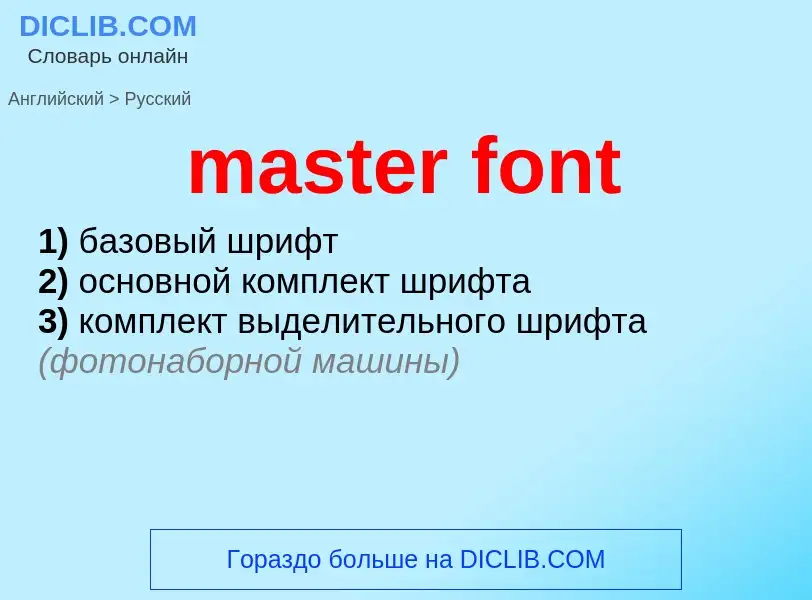Translation and analysis of words by ChatGPT artificial intelligence
On this page you can get a detailed analysis of a word or phrase, produced by the best artificial intelligence technology to date:
- how the word is used
- frequency of use
- it is used more often in oral or written speech
- word translation options
- usage examples (several phrases with translation)
- etymology
master font - translation to English
<font color="gray">общая лексикаfont>
экранный шрифт
растровый шрифт, разработанный для отображения информации на экране компьютера
<font color="gray">Смотрите такжеfont>
<font color="gray">общая лексикаfont>
векторный шрифт
шрифт, в котором символы описываются отрезками линий и дуг <font color="gray">(bitmapped font)font>. Это позволяет программно изменять кегель такого шрифта, поэтому векторные шрифты часто называют масштабируемыми шрифтами. У векторных шрифтов отсутствуют хинты и математически определяемые кривые, применяемые в контурных шрифтах
Definition
Wikipedia

Multiple master fonts (or MM fonts) are an extension to Adobe Systems' Type 1 PostScript fonts, now superseded by the advent of OpenType and, in particular, the introduction of OpenType Font Variations in OpenType 1.8, also called variable fonts.
Multiple master fonts contain two or more "masters"—that is, original font styles—and enable a user to interpolate between these masters along a continuous range of "axes." With proper application support, these axes could be adjusted on demand.
The intention was that using multiple master fonts, a designer can generate a style of the exact width, thickness and optical size wanted, without losing the integrity or readability of the character glyphs. The effect is similar to morphing, as a designer can choose an intermediate between two styles, for example generating a semibold font by compromising between a bold and regular style, or perhaps extend a trend to create an ultra-light or ultra-bold. This idea was not new, having been used by companies such as URW++, but Adobe hoped to develop the technology to a greater extent.
Adobe's goal in multiple master font technology was to allow end-users of fonts to create the exact font they needed for a situation, by adjusting parameters such as boldness or width. However, multiple master fonts proved unpopular in consumer-facing use due to the difficulty of writing (or rewriting) consumer desktop publishing applications to support them, and because font designers have generally preferred to release fonts in specific weights and styles, as font files that have been individually fine-tuned. However, the multiple master concept remains heavily used at font design studios, allowing designers to generate a range of weights and styles quickly and then optimise them individually. 'Multiple master' may therefore often be seen as a generic term describing interpolated font design generally, not necessarily using Adobe technology.
In 2016, Adobe, Google, Apple and Microsoft announced a new update to the OpenType specification, allowing variable fonts. Similar to the multiple master concept, this will allow custom styles to be generated from a single font file programatically.



![Nine weights of a [[serif]] font, created at the company [[URW++]] using interpolation. Nine weights of a [[serif]] font, created at the company [[URW++]] using interpolation.](https://commons.wikimedia.org/wiki/Special:FilePath/Interpolation von Schriften.jpg?width=200)
![Skia]]. This typeface was prepared using an Apple variant of multiple master technology. Skia]]. This typeface was prepared using an Apple variant of multiple master technology.](https://commons.wikimedia.org/wiki/Special:FilePath/Skia variants.png?width=200)
![URW]] of the typeface Leipziger Antiqua. The letters become higher in [[x-height]] and more widely spaced as the point size for which they are intended decreases. URW]] of the typeface Leipziger Antiqua. The letters become higher in [[x-height]] and more widely spaced as the point size for which they are intended decreases.](https://commons.wikimedia.org/wiki/Special:FilePath/Unterschiedliche Schriftformen pro Schriftgrösse.jpg?width=200)
![A bitmap color font for the [[Amiga OS]] A bitmap color font for the [[Amiga OS]]](https://commons.wikimedia.org/wiki/Special:FilePath/AmigaColorFont.png?width=200)
![Perpetua]] Perpetua]]](https://commons.wikimedia.org/wiki/Special:FilePath/Comparison of printed and digital versions of Perpetua.png?width=200)

![Macintosh operating system]] Macintosh operating system]]](https://commons.wikimedia.org/wiki/Special:FilePath/Original Mac fonts.png?width=200)
